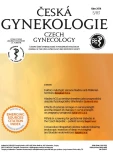Asherman‘s syndrome: the description of two case reports
Authors:
M. Miklošová 1; M. Mára 2
Authors place of work:
Gynekologicko-porodnické oddělení, Nemocnice Pardubického kraje, pracoviště Chrudimská nemocnice, primář MUDr. T. Pavlíček
1; Gynekologicko-porodnická klinika 1. LF UK a VFN, Praha, přednosta prof. MUDr. A. Martan, DrSc.
2
Published in the journal:
Ceska Gynekol 2018; 83(6): 440-444
Category:
Kazuistika
Summary
Objective:
To point out the importance of proper indication and careful performance of intrauterine surgical procedures. To highlight the key role of early diagnostic and treatment of intrauterine adhesions.
Setting:
Department of Obstetrics and Gynecology, Hospitals of Pardubice Region, Chrudim Hospital. Clinic of Obstetrics and Gynecology, General University Hospital in Prague and 1st Faculty of Medicine Charles university.
Design:
Case report.
Methods:
The description of 2 different cases of the patients with the Asherman´s syndrome.
Conclusion:
Asherman‘s syndrome is a serious condition with complicated treatment and uncertain prognosis regarding fertility. Primary prevention as well as timely diagnosis and treatment seems to be crucial in the management of this patology.
Keywords
Asherman‘s syndrome, intrauterine adhesions, surgical revision of uterine cavity, hysteroscopy
Zdroje
1. Ahmadi, F., Siahbazi, S., Akhbari, F., et al. Hysterosalpingography finding in intra uterine adhesion (Asherman‘s syndrome): a pictorial essay. Int J Fertil Steril, 2013, 7, p. 155–160.
2. Conforti, A., Alviggi, C., Mollo, A., et al. The management of Asherman syndrome: a review of literature. Reprod Biol Endocrinol, 2013, 11, p. 118.
3. Engelbrechtsen, L., Langhoff-Roos, J., Kjer, JJ., Istre, O. Placenta accreta: adherent placenta due to Asherman syndrome. Clin Case Rep, 2015, 3, p. 175–178.
4. Hrazdirová, L., Kužel, D., Žižka, Z. Ashermanův syndrom. I – historie, prevalence, histopatologie, klasifikace, etiologie, symptomatologie a vyšetřovací metody. Čes Gynek, 2010, 75, s. 492–498.
5. Hrazdirová, L., Kužel, D., Žižka, Z. Ashermanův syndrom. II – terapie, asistenční metody, prevence readhezí, komplikace a výsledky léčby. Čes Gynek, 2010, 75, s. 499–506.
6. Hrazdirová, L., Kužel, D., Žižka, Z. Je hysteroskopie správná volba pro řešení reziduí těhotenských tkání? Čes Gynek, 2012, 77, s. 35–38.
7. Kolařík, D., Halaška, M., Feyereisl, J. Repetitorium gynekologie, 2. aktualizované vyd. Praha: Maxdorf, 2011, 1086 s.
8. Kužel, D., Tóth, D., Mára, M., et al. Základy panoramatické hysteroskopie, 1. vyd. Praha: Grada Publishing, 2016, 192 s.
9. Křižan, V., Pánková, S., Hudeček, R. Význam hyaluronátu v gynekologii a porodnictví. Prakt Gyn 2012, 16(1), s. 7–12.
10. Santamaria, X., Cabanillas, S., Cervelló, I., et al. Autologous cell therapy with CD133+ bone marrow-derived stem cells for refractory Asherman‘s syndrome and endometrial atrophy: a pilot cohort study. Hum Reprod, 2016, 31, p. 1087–1096.
11. Singh, N., Mohanty, S., Seth, T., et al. Autologous stem cell transplantation in refractory Asherman‘s syndrome: a novel cell based therapy. J Hum Reprod Sci, 2014, 7, p. 93–98.
12. Smikle, C., Bhimji, SS. Asherman syndrome. In: StatPearls [Internet]. Treasure Island (FL): StatPearls Publishing, 2018.
Štítky
Detská gynekológia Gynekológia a pôrodníctvo Reprodukčná medicínaČlánok vyšiel v časopise
Česká gynekologie

2018 Číslo 6
- Ne každé mimoděložní těhotenství musí končit salpingektomií
- Mýty a fakta ohledně doporučení v těhotenství
- Je „freeze-all“ pro všechny? Odborníci na fertilitu diskutovali na virtuálním summitu
- I „pouhé“ doporučení znamená velkou pomoc. Nasměrujte své pacienty pod křídla Dobrých andělů
Najčítanejšie v tomto čísle
- Etiologie, rizikové faktory a metody prevence poporodní deprese
- Radiofrekvenční ablace endometria – nová možnost konzervativní léčby silného menstruačního krvácení
- Ashermanův syndrom: popis dvou případů
- Perinatálna mortalita a morbidita v Slovenskej republike v rokoch 2007–2015
